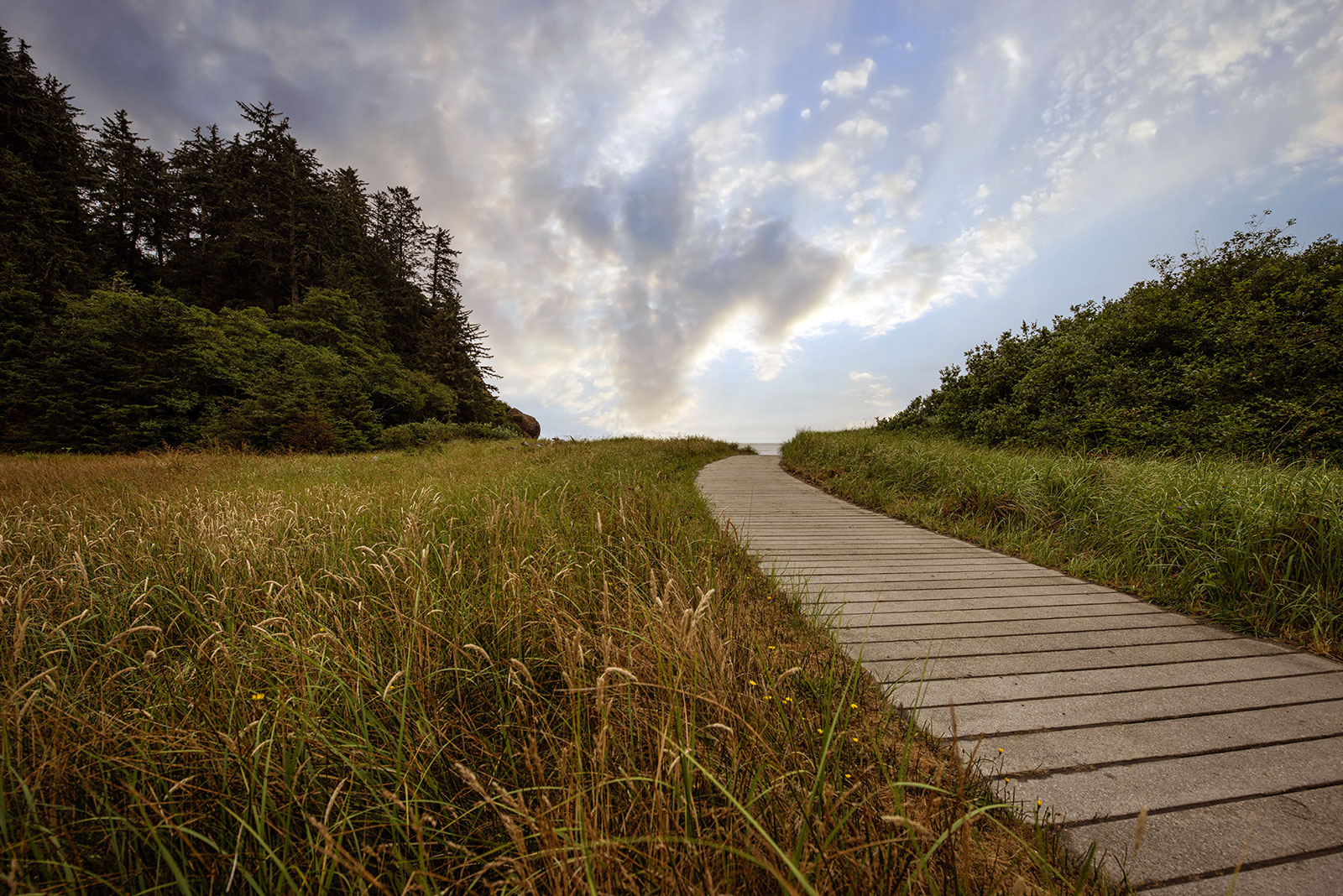
A Confluence of Peregrinations and Prayers
At Cape Disappointment near the mouth of the Columbia River, Maya Lin’s walkway and boardwalk present juxtaposing journeys of discovery.
BY LAURA J. COLE | September 11, 2023
There are slight variations in the creation story of Snoqualmie Falls, but all begin with a wish.
According to Snoqualmie Charlie*, long before the falls and the Snoqualmie people who called it home, two sisters camped outside under the night sky after a day spent gathering fern roots. As the younger sister, Ya’slibc, lay looking up at the stars, she wished upon a shining white star to be her husband and a shining red one to be her sister’s. The stars accepted, taking both girls into the sky while they slept.
The two awoke in Sky Country and began living out their days digging fern roots while their husbands hunted. The men, however, warned the sisters not to “follow those that go straight down but dig the roots that spread out.” After only a few days, Tukwiye’ became pregnant, eventually giving birth to a boy who would grow up to become Moon the Transformer.
When Moon was strong enough to join them as they gathered roots, the sisters resumed their duties and became curious about the roots that went straight down. They dug “until the wind came up through the hole.” For nearly two weeks, they collected cedar limbs and twisted them into a rope, until it was long enough to reach earth. When it finally did, they descended, covering up the hole in Sky Country, so their husbands would not know where they went.
Upon reaching the ground, the sisters turned the ladder into a swing that swung from Mount Si all the way to Rattlesnake Mountain, so all could celebrate their return. But amid their celebrations, Dog Salmon came and stole Moon.
Eventually, Bluejay found where Dog Salmon had taken Moon, only to discover that Moon was now a grown man, married to a Dog Salmon, and with boys of his own. Bluejay told Moon he had come to rescue him and that “your mother and aunt and all your people are sorrowing for you.”
Moon told Bluejay to leave without him and he would follow eventually—after he said goodbye to his son.
On his way back, Moon began changing things on earth. He transformed people into sandpipers and ducks, clams and beavers, bears and deer, wild artichokes and skunk cabbages, fire and rivers, and of course, into the various tribes, including the Snoqualmie, Puyallup, and Yakima.
He also changed a large fish weir into what is now Snoqualmie—sdukʷalbixʷ, a Lushootseed word meaning “moon”—Falls.
“It is all the work of Moon and no one else but Moon,” Snoqualmie Charlie said. “Moon has given us fish and game. … Though white people overwhelm us, it is Moon that placed us here, and the laws we are bound to obey are those established by Moon in the ancient time.”
* Snoqualmie Charlie, or sia’txted, was born around 1850. This version of the story was first published in 1929 by Arthur Ballard in The Mythology of Southern Puget Sound. I opted to defer to this version, even though there are earlier versions told by other tribe members, as it is the one cited most heavily in the application for the falls to be listed among the National Register of Historic Places, on signs at the falls, and appears to be the basis for a coloring book on the tribe’s website. I want to give a special thanks to the Oregon Historical Society in Portland for carrying a copy of the original, which I referenced for this article.
Timeline of Snoqualmie Falls
13,000 BPE
Earliest discovered archaeological site in the Snoqualmie Valley was created
1720s-30s
The Snoqualmie tribe began using horses for travel and transportation throughout the region
1851
Samuel Hancock, one of the first explorers to the Snoqualmie Valley, arrived in the region, thanks to the help of two Snoqualmie guides, and created the first written description of the area
1855
Point Elliott Treaty forced the Snoqualmie to go to the Snohomish Bay reservation, which later became part of the Tulalip Indian Reservation
1859
Point Elliot Treaty was ratified
1866
Snoqualmie Falls was removed from the care of the Snoqualmie people
1889
The first passenger trains arrived in the valley; 1,000 people showed up for the first train; entrepreneurs funded and built a railroad (the Seattle, Lake Shore and Eastern) into the valley for timber
1890
Snoqualmie Falls Hotel was constructed on the south side of the Falls
1898
The face of the falls was blasted away to construct a power plant (Plant 1) in the rock below
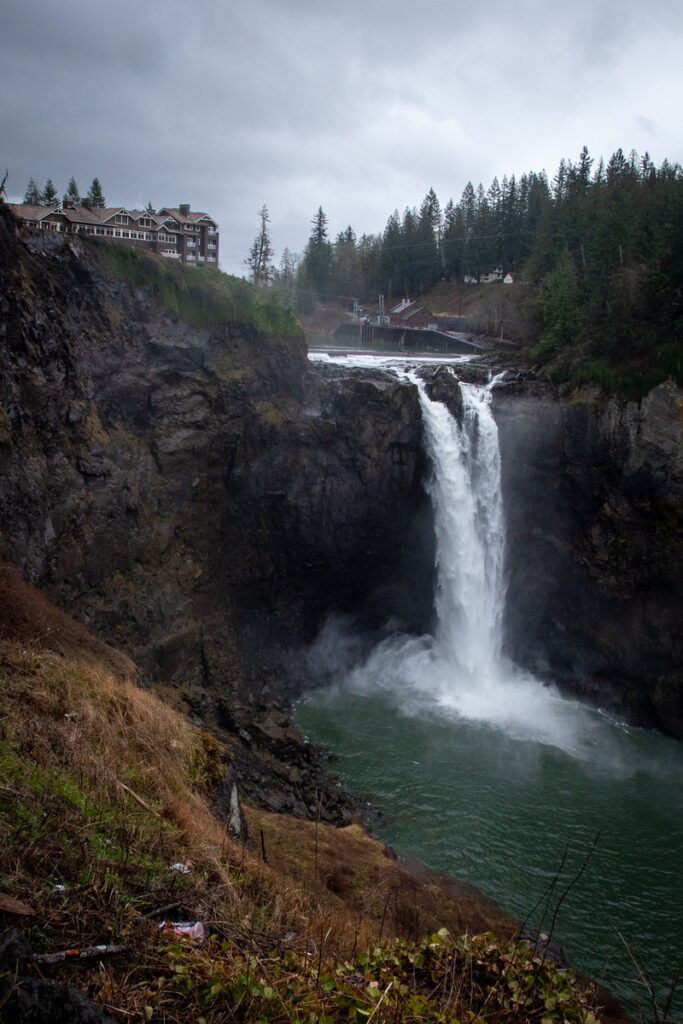
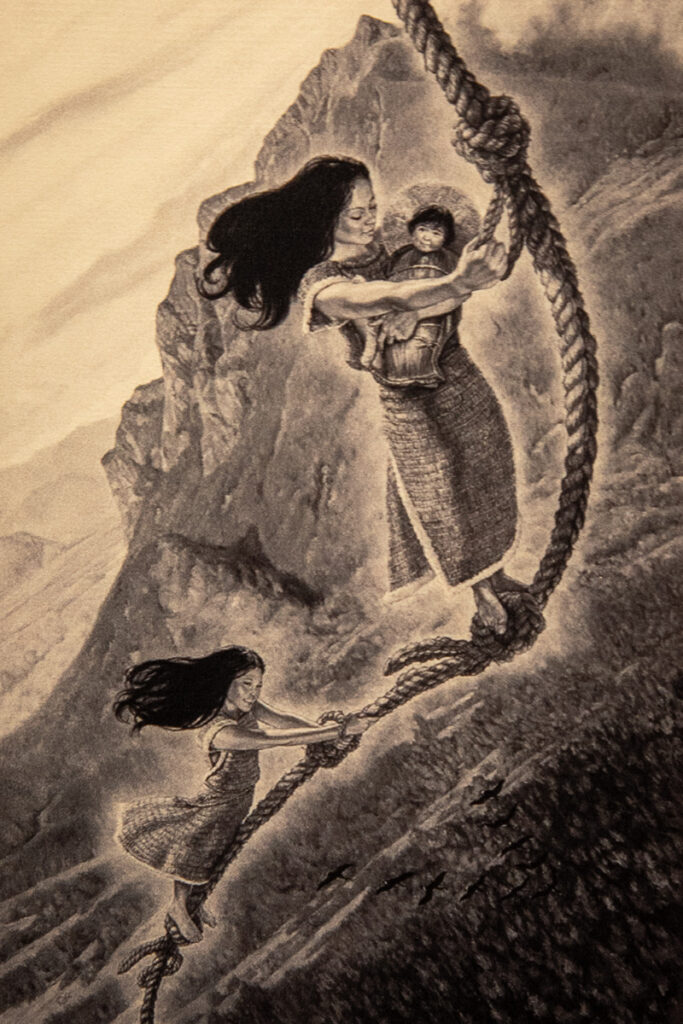
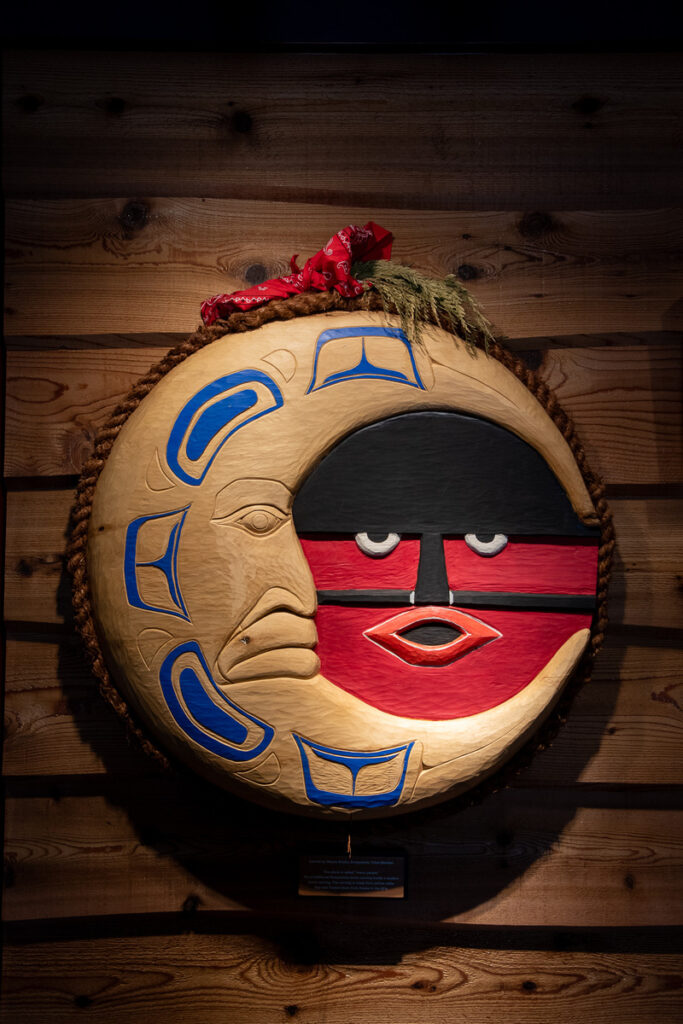
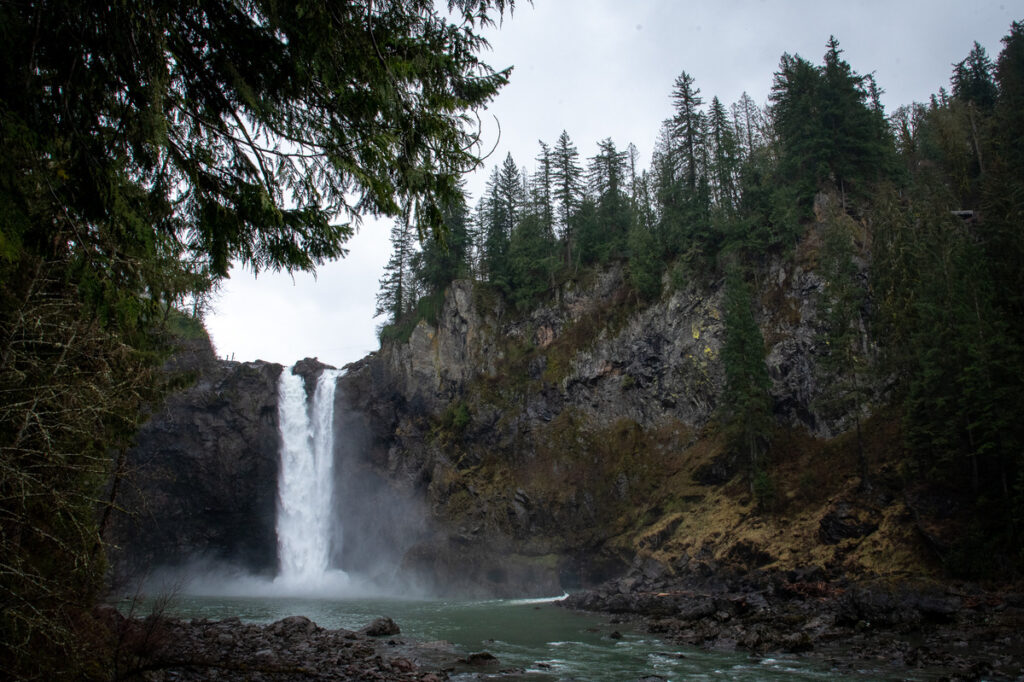
Snoqualmie Charlie told this story nearly a century ago. During that time, the Snoqualmie people had little or no say over what happened to Snoqualmie Falls, the 268-foot falls that more than a million people visit annually, as I did for the second time on the National Day of Prayer for the Protection of Native American Sacred Places.
For generations, members of the tribe have prayed, sought visions, and asked for help from the spirits dwelling within. But beginning in the 1800s, the Snoqualmie were forced to watch as a train, then a hotel, then two hydroelectric plants were built near the river—the first by blasting away part of the falls’ rock wall.
“When Charles Baker looked upon Snoqualmie Falls and felt what so many had before, he mistook that powerful energy as something to be diverted, harnessed, and sold for profit,” it says on a plaque inside the Snoqualmie Falls Gift Shop and Visitor Center.
A civil engineer, Charles Baker was only 23 when he built the world’s first completely underground hydroelectric plant. For some, it was a marvel. When it turned on in 1899, the plant, which is now run by Puget Sound Energy, provided power for Seattle, Tacoma, and Everett, as well as some of the towns in-between.
“The plant was one of the first to deliver alternating current (AC) power over a long distance, demonstrating the suitability of this technology,” it reads on the plaque designating the generating station a National Historic Civil Engineering Landmark in 1981. When it was built, hydroelectric power was still in its infancy. But by 1920, hydroelectric power was responsible for 25% of all US electrical generation. Today, hydropower accounts for 28.7% of total US renewable electricity generation but only 6.2% of the total electricity generation, according to the US Department of Energy.
Despite the engineering feat, the tribe has equated the plant’s placement to someone destroying part of the Sistine Chapel in the Vatican, the Western Wall in Jerusalem, or any other religion’s significant holy site.
“In 1898 there was no process for the public nor the Snoqualmie Indian Tribe to have input on whether the plant should be built at all,” the sign in the gift shop continues.
In fact, 143 years would pass between when the US government stripped the tribe’s right to make decisions for the falls to when Snoqualmie Falls became the first Traditional Cultural Property in Washington in 2009. Another decade would pass before the tribe was able to purchase the 45-acres surrounding the falls, including Salish Lodge & Spa. Though Puget Sound Energy has an agreement with the state to continue running operations of the hydroelectric plant until 2044, the Snoqualmie people now legally own the land and have full control over what takes place there.
“That pounding of the water is a sacred cycle, and that pounding and the mists rising [are] a connection of worlds,” Snoqualmie Tribal Elder Lois Sweet Dorman said in a 2019 article from Crosscut after the purchase.
Not only is the water considered holy, but the mists are believed to carry prayers and hopes up to the sky. Some tribal members, such as Mark Lauzen, also believe their ancestors’ spirits dwell inside the smoke-like vapors.
“If you look into the mists long and hard enough, our ancestors will reveal their spirits to you, and sometimes, you’ll see their faces,” he said, sharing a story his father told him as a kid about the scared place in a YouTube video.
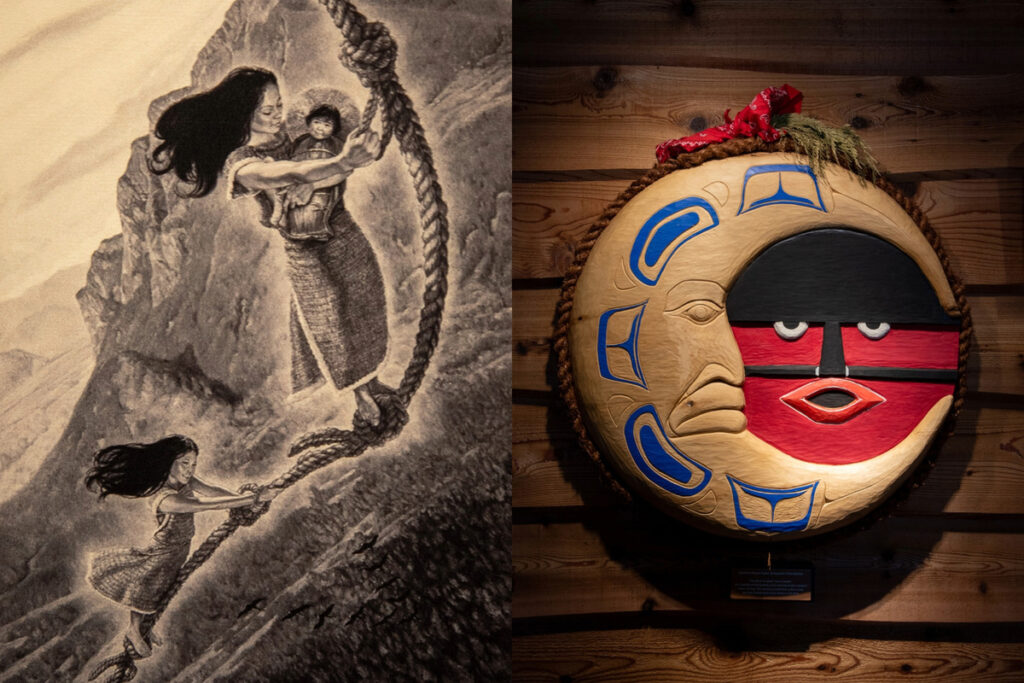
13,000 BPE
Earliest discovered archaeological site in the Snoqualmie Valley was created
1720s-30s
The Snoqualmie tribe began using horses for travel and transportation throughout the region
1851
Samuel Hancock, one of the first explorers to the Snoqualmie Valley, arrived in the region, thanks to the help of two Snoqualmie guides, and created the first written description of the area
1855
Point Elliott Treaty forced the Snoqualmie to go to the Snohomish Bay reservation, which later became part of the Tulalip Indian Reservation
1859
Point Elliot Treaty was ratified
1866
Snoqualmie Falls was removed from the care of the Snoqualmie people
1889
The first passenger trains arrived in the valley; 1,000 people showed up for the first train; entrepreneurs funded and built a railroad (the Seattle, Lake Shore and Eastern) into the valley for timber
1890
Snoqualmie Falls Hotel was constructed on the south side of the Falls
1898
The face of the falls was blasted away to construct a power plant (Plant 1) in the rock below
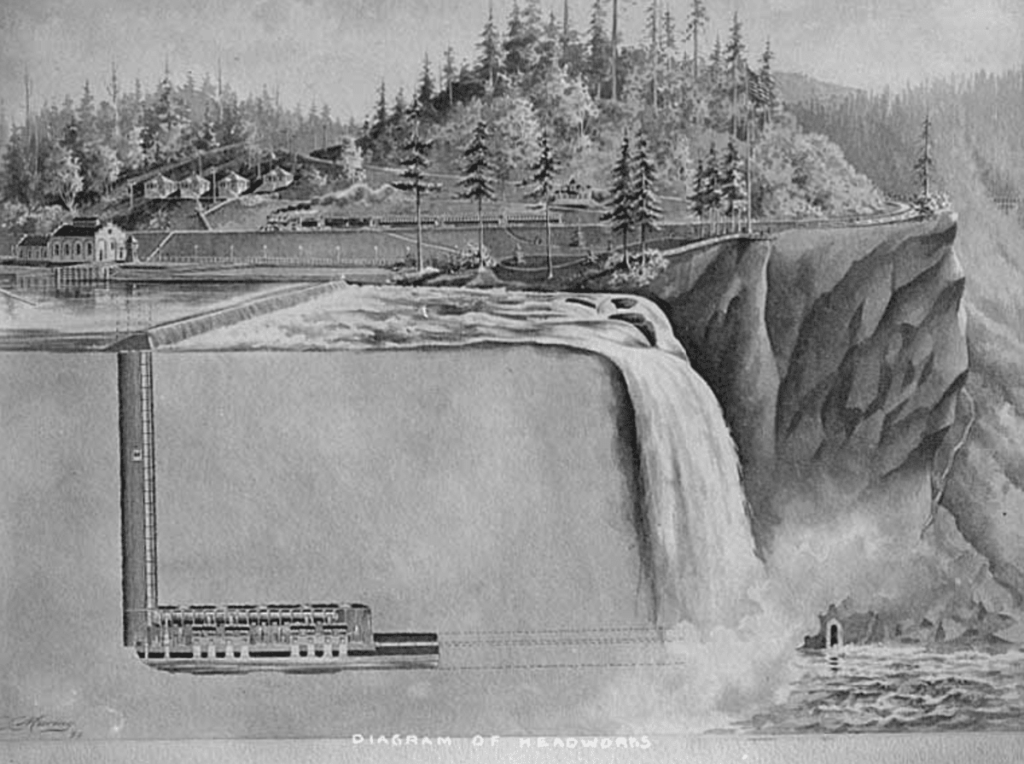
1899
Plant 1 began to produce energy for the first time on July 31, generating 6,000 kW
1905
Station was expanded
1910
Plant 2 was built a quarter-mile downstream of the Falls
1929
Arthur Ballard published the origin story for the first time in Mythology of Southern Puget Sound
1957
Plant 2 was expanded, nearly doubling the output
1988
Salish Lodge & Spa opened

1990
Twin Peaks, featuring the falls in the opening credit sequence, premiered on April 8
2004
Puget Sound Energy received a 40-year agreement to continue power generation operations from the Federal Energy Regulatory Commission
2009
Snoqualmie Falls was listed in the National Register of Historic Places, becoming the first Traditional Cultural Place in Washington
Nov. 1, 2019
Snoqualmie Tribe purchased 45 acres of land surrounding the falls, including the Salish Lodge & Spa

1899
Plant 1 began to produce energy for the first time on July 31, generating 6,000 kW
1905
Station was expanded
1910
Plant 2 was built a quarter-mile downstream of the Falls
1929
Arthur Ballard published the origin story for the first time in Mythology of Southern Puget Sound
1957
Plant 2 was expanded, nearly doubling the output
1988
Salish Lodge & Spa opened

1990
Twin Peaks, featuring
the falls in the opening
credit sequence, premiered
on April 8
2004
Puget Sound Energy received a 40-year agreement to continue power generation operations from the Federal Energy Regulatory Commission
2009
Snoqualmie Falls was listed in the National Register of Historic Places, becoming the first Traditional Cultural Place in Washington
Nov. 1, 2019
Snoqualmie Tribe purchased 45 acres of land surrounding the falls, including the Salish Lodge & Spa


At Cape Disappointment near the mouth of the Columbia River, Maya Lin’s walkway and boardwalk present juxtaposing journeys of discovery.
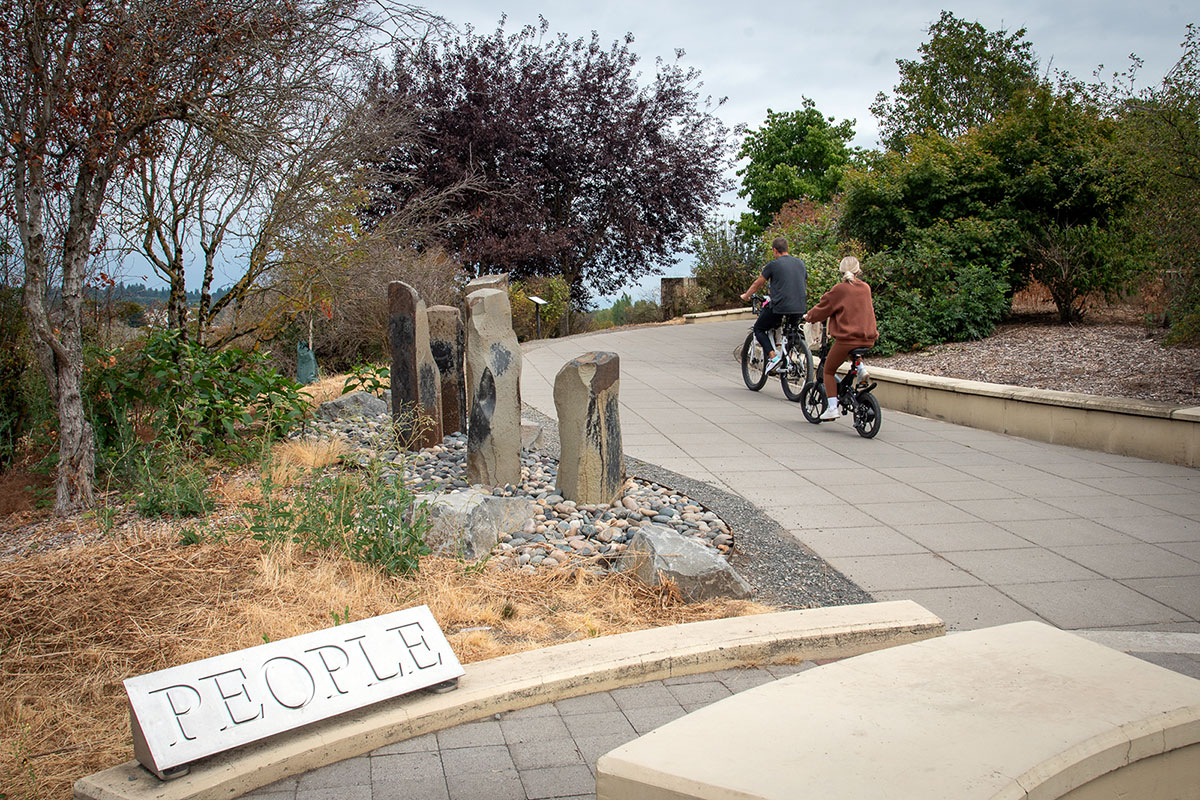
Located near the confluence of the Willamette and Columbia rivers, the Vancouver Land Bridge merges rivers, land, people, and trade.

